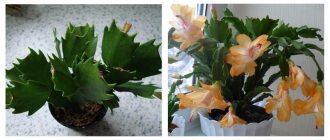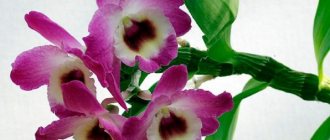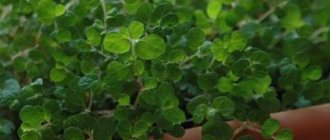Rozhdestvennik or Schlumberger. How to care for Christmas at home.
The Christmas flower is a magnificent house plant.
It is also called “Schlumbergera”, “Zygocactus” or “Decembrist”. From the very beginning of winter, this unpretentious flower does not hibernate, but begins to bloom, delighting everyone around with the splendor of bright colors until the end of winter. Christmas tree is one of the few plants that gives a good mood at a time when others go to sleep. I have two Schlumbergers growing and from my experience I can say that they do not require any special care, but if you do not follow the basic rules in lighting, watering, temperature conditions, etc., then you will not receive gratitude from him in the form of waterfalls of flowers .
In this article I will share with you my experience on how to properly grow Christmas trees.
| CONTENT |
The homeland of this relative is the hot South American and Brazilian tropics. Schlumbergera belongs to the genus of spineless epiphytic cacti that grow on the branches of other plants. In 1816, this plant was brought to Europe by Alan Cunningham and 42 years later it was named in honor of the famous collector of succulent plants, Frederick Schlumberger.
Rozhdestnik is a branching shrub with flat, small, jointed shoots with jagged edges. Schlumbergera flowers can come in a variety of colors, but the most common are red, lilac, pink, white, purple and orange. They range in size from 4 to 8 cm and are located at the ends of the plant stems. Due to the fact that the buds open rather slowly, the Christmas tree blooms for about 2-3 months throughout the winter.
Nowadays, flower growers have artificially bred many hybrid species of Christmas trees, differing from each other in stems, sizes and colors of flowers. We will consider only the most popular of them.
- Schlumbergara Bukleya is also called “Decembrist” or “Varvarin color”. In nature, it grows in the tropical rainforests of northern Brazil. This zygocactus has flowers up to 8 cm in length with a large number of pink-purple oblong petals with pointed ends. The flowers of this Christmas tree have a radially symmetrical shape.
- Schlumbergera Truncata or Truncata . This plant most often has straight or partially spreading stems, consisting of a small number of segments with pointed teeth along the edges. The flowers of this Schlubrerger do not have radial symmetry, but they have several dozen different shades of color, for example, orange-red, white, red, yellow, peach, salmon, etc.
In addition to these plants, breeders are constantly working to create new species by crossing Schlumbergera Bucleai, Schlumbergera Truncata and Ripsalidopsis (Hatiora or Easter cactus) with each other. As a result, many new plants of this species were obtained: Gold Cream, Exotica, Christmas Chi, Aspen, Madonna, Joyce Car, Paula, Madama Butterfly, Tynesed, etc.
| Reference. There is a very Christmas-like flower called Rhipsalidopsis or “Easter cactus”. Outwardly, it is difficult to distinguish them from each other, especially for non-gardeners. The main difference between them is that ripsalidopsis (hatiora) blooms in the spring, which is why it is popularly called the “Easter cactus,” and Schlumbergera (zygocactus) dresses in flowers in the winter, which is why its popular name is “Christmas cactus” or Decembrist. Their flowers are also different: the corollas of the Christmas tree are slightly slanted, while those of the ripsalidopsis are symmetrical. |
As I already said, the Christmas tree is not a whimsical plant, but for its good health it is necessary to follow some simple rules.
Christmas lighting. The Christmas tree is not demanding on lighting, but does not like direct sunlight, as it causes burns to the plant. It feels best in diffused light. Window sills with windows facing west or east are well suited for this flower, and if the pot with the plant is on the south window, then Schlumbergera must be shaded.
Watering the Christmas tree. Watering Schlumberger should be moderate, that is, only after the top 1-3 cm layer of soil has dried. In no case should the plant be over-watered, as with constant waterlogging, the roots of the Christmas tree begin to rot and the plant gradually dies. It must be watered with soft water at room temperature.
Spraying and air humidity for Christmas. Schlumbergera, like many tropical plants, such as spathiphyllum, loves to be sprayed. On hot days of summer this can be done several times a week, and in winter in a warm room - 1-2 times a month. For spraying, use a spray bottle or shower. The water for this operation should be soft at room temperature.
Christmas tree loves high air humidity, so in addition to spraying, you can place a tray with wet expanded clay under its pot.
Temperature for Christmas. Schlumbergera is quite resistant to heat and cold. It can withstand a temperature range from 20C to 38-39C, but feels most comfortable in summer at 18-20C and in winter from 13C to 18C. If in winter the Christmas tree is on the windowsill near a heating device, for example, near a radiator, then move it as close to the window as possible. In the summer, you can take it out into the fresh air on the balcony or place the pot in the garden under a tree. But at the same time it is necessary to ensure that slugs and snails do not attack it.
Christmas feeding. It is necessary to fertilize Schlumbergera with special fertilizers for cacti, which are sold in flower shops. This must be done 2 times a month during the growth period of the plant, that is, from March to August.
Soil for Christmas. Store-bought soil mixtures intended for cacti are excellent for Schlumberger. It should be leafy and be able to absorb moisture and air well. You can also prepare the soil for Christmas yourself from:
- Sod land - 1 part;
- Leaf soil - 1 part;
- Peat – 1 part;
- Clean coarse river sand – 1 part.
Christmas tree transplant. Young Schlumbergeras grow quite quickly, so they need to be replanted at least once every 2-3 years, and adult individuals - as necessary, but at least once every 4-5 years. These plants do not have powerful root systems, so they do not require large pots. For replanting, use the soil mixture described in the subsection “Soil for Christmas.”
In order not to damage the roots of the Christmas tree, replanting must be done by transshipment. First, make sure there is good drainage. To do this, place 1-2 layers of small expanded clay or stones on the bottom of the new pot (it should be larger than the previous one), then sprinkle the drainage with soil mixture (1-3 cm). Then remove the plant along with the soil from the old pot. There is no need to remove all the soil from the roots. Remove only the soil that comes off easily. Then place the Schlumbergera in the center of the pot and carefully and evenly add the missing soil on all sides to prevent the plant from leaning over. There is no need to compact the soil too much, just tap the pot on all sides.
After transplanting, water the plant generously and place it in a permanent place. The following waterings are carried out after the top layer of soil has dried.
Schlumberger can be propagated in two ways - stem cuttings or grafting, but most often the first method is used, so we will not consider propagation by grafting.
Propagation of Christmas tree by cuttings. Schlumbergera is propagated by cuttings from April to May. To do this, you need to carefully unscrew the stem cuttings with 3 or 5 segments from the mother plant (do not cut them under any circumstances!). Then put them in a dry, dark and warm place for a day to dry. After this, it is necessary to plant the cuttings in small temporary containers with an earthen mixture. To create greenhouse conditions, cover the cuttings of young Christmas trees with jars or cut plastic bottles. Before rooting, this usually takes up to 1 month, do not forget to remove the covers for 20-30 minutes every day to ventilate the plants. Young plants need to be watered abundantly. After rooting, you will see new segments on the cuttings. After this, the plants can be transplanted into permanent pots. But they should not be too bulky, as a large amount of wet soil will weaken the young plants.
Schlumbergeras rarely get sick, but anything can happen, so you need to know how to deal with them.
The Christmas tree is not blooming. Many Schlumbergera lovers are puzzled as to why the Christmas tree does not bloom. Most often, the reason for this is improper lighting or insufficiently fertilized soil. For a plant to bloom, it must have enough light, but not direct sunlight. It is not recommended to place a pot with a plant on northern windowsills, but on southern windowsills it must be shaded. It is also necessary to periodically fertilize the Christmas tree. And if the plant has thrown out its buds, then do not turn it, much less move it to another place. If you do this, it may simply drop flowers and not even think about flowering for a long time.
The Christmas tree is fading. The reason that Schlumbergera withers may be insufficient watering, too dry air, for example due to a battery, or a lack of nutrients in the soil. All that is necessary to correct this situation is to normalize the frequency of watering, spray the plant more often and fertilize or completely change the soil. You can also place a tray with wet expanded clay under the pot to humidify the air.
Christmas segments are disappearing. Most likely, your Schlumberger's segments are falling off due to very wet soil. These plants do not tolerate “swamps”, since they have more similarities with cacti than with moisture-loving plants, such as, for example, white calla. If the root of a Christmas tree begins to rot, then most likely the plant will die due to infection by fungi and bacteria. You can, of course, transplant it into new soil, but it is better to play it safe and urgently plant new cuttings.
At home, with good care, Christmas trees are rarely attacked by pests, but no one is 100% immune from this.
Mealybug on Christmas tree. Most often, Schlumberger is attacked by mealybugs, which form white lumps between the shoots of the plant. At the initial stage, to remove them, wipe the affected areas well with a soft cloth soaked in alcohol. If this does not help, then buy any remedy for mealybugs at a flower shop that can be used indoors and use it according to the instructions.
Spider mites at the Christmas tree. In addition to mealybugs, Schlumberger is also attacked by pests of indoor plants such as spider mites. It is not difficult to notice them, since they wrap a very thin web around the plant. You can get rid of them using the drug “Actellik”.
| Conclusion. Christmas tree is one of the few indoor plants that blooms throughout the winter, thereby lifting the mood of its owners and adding bright colors to gray gloomy days. |
PS Especially in winter, all types of Christmas celebrations have a beneficial effect on the atmosphere in the house, raising the mood of everyone around.
Interesting on YouTube:
Related materials:
Author: Yulia IgresiSpecially for: House of Knowledge1111111111 Rating 4.35 (10 Votes) Did you like the article? Share it with your friends
Is there an error in the text? Highlight it and Click:
More on the topic:
If the article is useful to you, do not hesitate and leave your comments. Thanks for visiting. Add a comment
Possible problems when growing Christmas trees
The Christmas tree is slightly susceptible to diseases and pests, but anything can happen, so it is better to know in advance how to deal with them.
Signs of improper care
The following signs may indicate that the flower is not being properly cared for
- Decembrist does not bloom. Many people are looking for the reason why the plant does not bloom. Basically, the main reason for this is improper lighting or poorly fertilized soil. In order for a flower to bloom, it must be provided with good lighting without direct sunlight. But you should also not place the plant on the north side, and on the south it should be shaded. You also need to feed the flower. You cannot turn over or rearrange the flower pot when buds appear.
- The Christmas tree is fading. The main reason for this may be infrequent watering, dry air or a lack of nutrients in the soil. It is necessary to normalize watering and spraying of the plant, fertilize and completely change the soil. For more effective moistening, you can place a tray with wet expanded clay under the flowerpot.
- Segments fall off. The main reason is waterlogged soil. Christmas trees do not tolerate overwatered soil. In this case, you need to ensure proper, moderate watering.
- The roots rot. If a flower's roots rot, it will most likely die. The reason lies in the appearance of bacteria or fungi. You can try replanting it in new soil, but this rarely saves the Christmas tree.
Pests
With proper care at home, the Christmas tree is rarely attacked by insects. But if this happens , then gardeners are faced with the following pests:
- Mealybug. It is he who attacks the flower more often than others, forming white lumps between the shoots. To begin with, you can remove the pest manually. To do this, wipe the affected areas with a cloth soaked in alcohol. If this does not help, then you can use special medicines against mealybugs.
- Spider mite. It is not difficult to see this pest. The mite wraps itself around the entire flower with a thin web. To combat it, chemicals are used, which are sold in special stores.
To summarize, we can say that the beautiful and abundant flowering of the Christmas tree captivates at first sight. And a Christmas tree that has been properly cared for will bloom for many years.
Pests and diseases
Usually the Christmas tree does not get sick, but care at home, if not carried out at the proper level, can lead to fungal diseases, which include phytium and fusarium. For these diseases, “Maxim” medicines for diseases will help. Home care also requires being prepared for the fact that you will need to quickly and effectively combat bacterial plant diseases. Please note: often these ailments are accompanied by discoloration of the stem, which immediately catches the eye. In addition, the disease can manifest itself by the formation of an unusual red color in the stem area, so you can quickly recognize the emerging problem.
Antibacterial drugs are effective in a minimal number of cases. It is necessary to remove as quickly as possible the part of the stem that was affected. If this is not done in time, you can lose the plant, you can consider it lost.
1 Plant characteristics
Shlumbergera belongs to epiphytes - plants that grow on the branches and trunks of trees or in rock crevices, most often these are representatives of tropical flora. Christmas tree naturally lives in the tropical rainforests of Brazil and is a succulent - it stores water in the thickness of its stems and leaves. This is an ampelous plant with long drooping shoots, at the end of which single flowers 5-7 cm in size are formed. To achieve abundant flowering, it is necessary to create growing conditions for it that are close to its natural habitat.
The life cycle of a Christmas tree at home consists of 4 periods. If you follow the care regimen described in the table step by step, the plant will “thank you” with an abundance of large flowers:
| Physiological stage | A period of time | Rules of care |
| Physiological rest | September October November | Watering is limited (once every 7 days), the optimal growing temperature is +16-18 degrees. No additional lighting required. Towards the end of the period, watering is gradually increased, spraying is carried out |
| Budding | November December | Abundant regular watering, frequent spraying, high air temperature (+30 degrees) |
| Bloom | December – February | Abundant regular watering, frequent spraying, hot air. The plant reacts to any change in conditions by dropping flowers. |
| Active growth | March – August (September) | Regular watering with warm water, growing temperature +22-25 degrees, spraying, fertilizing with mineral fertilizers, good air ventilation |
We recommend Cycas revoluta: how to properly care for this plant at home?
What are the enemies of zygocactus?
Rozhdestvennik is prone to fungal infections: late blight and phytium, as well as fusarium. The latter is combated with fungicides, and the rest with the preparations “Maxim”, “Vitaros”, “Topaz”.
Bacterial diseases begin with a dark spot at the base of the shoot. Gradually, the disease spreads to the entire stem, causing it to discolor and appear reddish. Only removing the affected stem can help the plant. In advanced cases, you need to have time to take a healthy cutting and grow it. The bush itself is already doomed to death.
The list of pests that plague zygocactus includes spider mites and mealybugs that resemble white cotton balls. To treat plants, use “Aktellik”, “Fitoverm” or “Aktar”.
Watch also the video on the topic:
Rozhdestvennik: care at home
You can grow a beautiful, healthy and flowering plant at home only with proper care. The flower is classified as a group of whimsical house plants . Optimal conditions should be created for him, which should be close to his natural habitat. Caring for a Christmas tree is different from caring for regular cacti. It is closer to the requirements of indoor deciduous plants.
When growing Christmas trees, care recommendations should be taken into account.
Selecting a location
The plant is unpretentious to lighting; the only thing that can harm it is direct sunlight, which can lead to burns of the leaves.
A fairly bright place where there is no direct sunlight is suitable for placing the Christmas tree The level of sunlight should be in the range of 70–85%.
Watering and moistening
The plant needs to be watered in the same way as other deciduous plants. Watering is moderate, determined as the soil dries. During the flowering period, the Christmas tree needs abundant and frequent watering. The plant should not be overly flooded; in this case, the thin and rather fragile root system may rot. The soil should always be slightly moist. Watering is reduced after flowering.
In the warm season, the plant is watered as the soil dries completely. With the onset of cold weather, the flower is removed to a cool place and watering is reduced. Water for irrigation should be soft and at room temperature.
Temperature
The Christmas tree is unpretentious to temperature. But it is important to avoid sudden temperature changes. The best temperature for flower growth is 18–25 degrees. In autumn, the Decembrist should be provided with at least 15 degrees. In such conditions, the plant will get stronger before winter flowering.
When the first buds appear, the Christmas tree should be placed in a room with a temperature of about 20 degrees. After flowering, it is again removed to a cool place. To obtain good flowering, it is very important to observe the temperature regime.
Soil and fertilizers
A special soil mixture for cacti is quite suitable for Christmas. It is important that the soil has good absorbent qualities. Although such a mixture can be prepared at home. To do this, you will need the following components in equal proportions:
- leaf and turf soil;
- peat;
- clean and coarse river sand.
As for feeding, the Decembrist is not particularly demanding of them. He needs fertilizers only for proper growth and development. The optimal fertilizer for it will be a mixture of potassium, nitrogen and phosphorus, which are added to the water. The plant should be fed until the first buds form.
Circumcision, transplantation, reproduction
Simply trimming the Christmas tree is enough. This is done for a beautiful and even crown. Over time, you will notice that the stems gradually begin to branch; this does not add elegance to the plant itself and pruning is necessary. You will just need to gradually remove the stem links, which from the outside seem superfluous, and also remove old branches from the plant. These shoots can be immediately used for propagation by cuttings.
If you decide to replant a Christmas tree, remember that according to the recommendations of experts, it is advisable to replant the plant every 2-3 years. Care at home involves replanting with just such regularity. If the plant is no longer young, then it needs to be replanted much less frequently - once every 4-5 years. Conveniently, the plant does not need a large pot. You will need a drainage layer, as well as 2/3 of a pot of substrate that you make yourself. If we talk about soil, home care involves the use of sand, peat, foliage and a turf layer for planting. It is better to do this in mid-March.
Christmas tree propagates by cuttings. Cuttings that contain only 3-5 segments are perfect for this. It is necessary to bury them in a sufficiently moist substrate. This does not require a deep container, but the plant will feel very good. Christmas tree takes root better when a glass jar or bottle is placed on top, but with the neck cut off, which allows you to organize a greenhouse. To prevent the cutting from rotting, you need to regularly lift the jar so that oxygen penetrates there.
It is important to note that the plant is suitable for those who have no experience in growing indoor flowers. When replanting or propagation of plants occurs quickly and does not require additional equipment, minerals or enormous floriculture experience, caring for them becomes much more pleasant.
Flower propagation
Schlumbergera is propagated in two ways - grafting or stem cuttings.
Propagation by grafting is used quite rarely, so we will focus on the popular cuttings. To propagate using this method, Schlumbergers carefully unscrew stem cuttings with several segments from the mother plant. Then they are placed to dry, which takes place in a dry, dark and warm place for 24 hours. After this, you need to plant the cuttings in containers with an earthen mixture and create greenhouse conditions for them. To do this, cover them with cut plastic bottles or cans.
During the process of rooting cuttings, which occurs over the course of a month, you need to ventilate them every day for half an hour and water them abundantly. When new segments appear, the plant needs to be transplanted to a permanent place of residence in pre-prepared pots. To prevent young plants from weakening from a large amount of wet soil, pots are selected in containers appropriate to the seedlings.
Perennial chrysanthemum: description, planting and care
4 Rules for transplanting, pruning and propagation
Decembrist is easily propagated by cuttings, like all epiphytic plants.
A suitable reason for vegetative propagation is annual pruning, which helps to form a uniform crown of the plant. Long unbranched and old shoots are trimmed. Without regular pruning, flowering may be poor.
To get new bushes from cuttings left after pruning, you need to follow a simple scheme:
- 1. Select young shoot tips, consisting of 1-3 segments.
- 2. Using the lower end, deepen the cuttings into the substrate or settled water by 1-2 cm.
- 3. Cover the cuttings with film to create greenhouse conditions.
- 4. Raise the film daily for 20-30 minutes for ventilation.
- 5. After the roots have appeared and the growth of the top has been activated, plant the seedlings in a suitable pot.
Young plants are replanted after flowering every year, old plants - once every 3-4 years. Replanting is carried out carefully so as not to damage the roots; it is best to use the transfer method - save the old lump of substrate, and if necessary, add new soil. The size of the pot is increased slightly with each transplant. It is important to choose the right size, because a pot that is too loose can cause water stagnation and root rot.
How does the Christmas tree reproduce?
Decembrist can be propagated by cuttings, dividing an adult bush and grafting.
Stem cuttings are prepared from 3-5 members. They do this in April-May. They are slightly dried during the day in a warm, dry place and placed in shallow containers with a moist substrate. To create a greenhouse effect, cover with film, a glass jar or the top of a plastic bottle. The shelter is periodically removed for ventilation. Ample watering is recommended. You will have to wait about a month for the roots to appear. The rooted sprout is transplanted into a small pot. A large amount of wet soil is not good for a fragile plant.
Experienced gardeners are experimenting with the Schlumberger graft. The main plant used is prickly pear or prickly pereskia. Their branched top is cut off, and the stem, freed from leaves, is split at the top.
Reproduction by segments
The zygocactus graft is taken from 2-3 segments. The cut is sharpened and inserted into the crevice. For fixation, use a patch, needle or awl. Engraftment should occur within 2 weeks. During this period, the room temperature is maintained at 18-20 ºC. When the leaves begin to grow, the constricting lining is removed. Decembrist grafted in mid-spring will bloom in the same winter.
Lack of flowering: disease or poor care?
Flower growers often ask why the Christmas tree does not bloom. Some believe that the main problem here is some kind of fungal disease. But actually it is not. Most often, everything is much simpler - the soil or lighting is not suitable for the plant. Do not place the flowerpot in direct sunlight. Such a plant will definitely not bloom. In a cool room, you cannot place a zygocactus on a north-facing window sill. At the end of autumn, when buds are being laid, it is very important that the air in the room remains humidified. But usually the heating season begins at this time. And with central heating and the inability to regulate humidity and temperature, an unfavorable microclimate can form for this flower.
Lack of flowering of zygocactus
Some believe that if there is a zygocactus in the house, caring for it necessarily involves the formation of a neat crown. And they make a serious mistake. By pinching the top leaves, flower growers themselves destroy the flower buds. It is not surprising that the plant is not going to bloom after this.
There is one more nuance. In spring, this cactus needs updating. To do this, cuttings consisting of several leaves are rooted in specially selected soil. The seedlings are covered with a plastic bag, creating conditions similar to a greenhouse. At this time, flower pots are moved to another place. Under no circumstances should condensation form inside such an improvised greenhouse. Even when the plant has taken root, you should not immediately open the flowerpot; you need to wait a few days.
Rozhdestvennik: brief description
Although the correct name for the plant is Schlumbergera, other names are used in the literature. Most often it is called zygocactus, but there are other options: epiphyllum, epiphyllanthus, zygocereus, etc. All these are synonyms. The flower received its correct Latin name in honor of Frederic Schlumberger, a famous French collector of succulents and cacti, who made an invaluable contribution to their study. But it was not he who discovered this plant, but the collector Allan Cunningham at the beginning of the 19th century.
Christmas flower (Schlumberger, Decembrist)
In Russia, the folk names of this plant are more popular. All of them are associated with unusual flowering times. For example, “Decembrist” and “December”.
This plant is a branching shrub. Its shoots are flat and jointed. It differs from other cacti in that it does not have spines, but has jagged edges. In winter, beautiful flowers appear on this plant - they are quite large, can reach 8 cm in length. Their shades can also be different - from pale pink to red and even purple.
Home care
Any plant requires appropriate care based on its natural predispositions. The Christmas cactus is also no exception, although it is not particularly whimsical.
- Lighting. The Christmas cactus does not like direct sunlight. To avoid burns, it is advisable to place it away from direct sunlight. A good option for this would be window sills that face east or west. If the location of the windows does not allow this, then the pot with the plant must be shaded.
- Watering. Schlumbergera should be watered only after the top layer of soil has dried a few centimeters. Strong humidity and flooding can lead to rotting of the roots and death of the plant. Watering should be done with settled water at room temperature.
- Required air humidity and Christmas tree spraying.
Many tropical plants, which include Schlumbergera, require special care and certain conditions. To create the desired humidity regime, you need to carry out systematic spraying. In the hot season, this is done several times during the week, and in winter, in a warm room, at least once a month. For these purposes, a shower or spray bottle is usually used. The water should be soft and at room temperature. The Christmas tree is a fan of high air humidity, so in addition to the spraying procedure, you can place a container with wet expanded clay under its pot.
- Temperature conditions. Rozhdestvennik is a fairly resistant plant to cool and heat. It can withstand temperatures of almost 40 degrees Celsius. Although the optimal temperature for growing it is 20–25 degrees. In winter, it is advisable to move it away from the hot radiator and place it closer to the window. In summer, he loves fresh air and the proximity of trees. Therefore, if you have a dacha or a personal plot, you can take it out into the garden and into the bosom of nature. You just need to make sure that it is not disturbed by snails or slugs.
- Feeding. Several times a month , especially during the growth period (March - August), the Christmas tree needs special feeding. But it's not a problem. They are sold in almost any flower shop.
- Soil for Christmas. Store-bought soil mixtures designed for cacti are quite suitable for this plant. The main criterion for this soil mixture should be good air and moisture absorption, as well as its leaf base. Although you can prepare such soil yourself at home. To do this, you need the following components in unambiguous proportions: turf soil, leaf soil, peat, coarse clean river sand.
Perennial rudbeckia: description, care and cultivation
Top dressing
Any ready-made fertilizer for succulents (cacti) is suitable for feeding. If you use fertilizers for other indoor plants, then before applying they must be diluted 2-3 times from the recommended norm - in the case of Decembrist, it is better to underfeed than to overfeed. In the spring, Decembrist is fed once a month, in the summer, during the active growing season - twice a month, in September feeding is stopped.
Beautiful soft pink flowers
general information
The Christmas tree is native to the Brazilian and South American tropics . Schlumbergera belongs to the genus of epiphytic thornless cacti. It is a branching plant with flat, small shoots and jagged edges.
Christmas flowers come in a variety of colors, but lilac, red, white, pink, purple and orange are often found in the color palette. The size of the flowers reaches 8 cm, and they flaunt at the ends of the stems of the Christmas tree.
The buds of the Christmas cactus open rather slowly, and the main flowering period occurs in almost all winter months.
Caring for Christmas at home
Caring for the Decembrist at home comes down to taking into account its characteristics.
Watering
The soil in which the Christmas tree grows should not dry out, so watering is needed quite often, although moderately. You shouldn’t overwater the flower either; the roots of the plant don’t like dampness. Therefore, the Decembrist needs drainage.
The Christmas tree needs to be watered regularly in spring and summer, but in autumn and winter, before the buds appear, watering should be reduced somewhat. In the summer, it is advisable to take the Christmas tree out into the open air, for example on a balcony or veranda.
After autumn arrives and watering becomes less frequent, the plant should be moved to a cool room, the temperature in which does not exceed 18 degrees. After the buds appear on Christmas Day, watering should be increased again.
Priming
For Christmas, cactus soil, which is sold in specialized flower shops, is quite suitable. This soil is light, loose, absorbs water well and allows oxygen to pass through. Do not forget that the flower definitely needs drainage.
Lighting
As we have already said, you should not place a Christmas tree on a south window, because this flower does not like direct sunlight. It is advisable that the rays of the morning or evening sun fall on it, because the Decembrist needs light.
If the apartment windows face south, simply move the plant away from the window, or, if this is not possible, simply shade the plant. The Christmas tree also does not like drafts, so you should be careful when ventilating the room.
Temperature
The best temperature for Christmas tree growth ranges from 22 to 25 degrees, although in general this flower is stable and tolerates both low and high temperatures quite well. It's not too hot for Christmas. nor a sudden cold snap. This is a very resilient plant.
Top dressing
Like any ornamental houseplant, the Christmas tree needs to be fed periodically. It is best to purchase special fertilizer for cacti and apply it to the soil according to the instructions. This should be done at least once a month.
Trimming
The plant should be pruned primarily for beauty, in order to form its shoots even and neat, otherwise, as a result of the branching of the stems, the Christmas tree looks “unkempt.”
There is nothing complicated about home pruning - you just need to carefully cut off those parts of the stems that seem unnecessary and too long to you. These cut off shoots can then be used to propagate Christmas trees.
Transfer
The Christmas tree is replanted after it blooms, around mid-March. It is advisable to replant young plants once every three years. and adults - once every five years. The Christmas tree's roots are not very large, so it does not need more frequent replanting.
The diameter of the new pot should be several centimeters larger than the previous one. The pot needs to be filled about a third full with drainage, which is necessary for the plant, and soil for cacti. After planting, it is advisable to lightly compact the soil around the flower.
Sources used:
- https://domznaniy.info/rozhdestvennik-ukhod.html
- https://uchidoma.ru/rozhdestvennik/
- https://naogorode.net/rozhdestvennik-uxod-v-domashnix-usloviyax/
- https://fikus.guru/komnatnye-cvety-i-rasteniya/cvetok-rozhdestvennik-vyraschivanie-v-domashnih-usloviyah.html
- https://domocvet.com/tsveti/tsvetok-rozhdestvennik-pravilnyiy-uhod-i-razmnozhenie
- https://sadovod.guru/komnatnye-rasteniya/kaktusy-i-sukkulenty/chto-predstavlyaet-tsvetok-rozhdestvennik.html
- https://sornyakov.net/flowers/rozhdestvennik.html
Planting and replanting zygocacti
Planting a young flower is not difficult, because they mostly reproduce from fragments of the stems of mother plants. Only to create new hybrids do flower growers grow Christmas trees from seeds.
It is especially convenient to do this during the period of bush formation after the end of flowering, when adult plants are not pruned, but the terminal segments of the stems are carefully unscrewed to give the flower a beautiful appearance.
I leave the resulting cuttings to dry, spread out one at a time, for a period of 1 to 7 days (flower growers have different recommendations on this matter). After callus has formed, they are planted, only slightly buried in the soil, in small pots with fertile soil, covered with transparent film or a glass jar and placed in a slightly shaded place. The temperature here should be between 15–20ºС.
For successful rooting, cuttings need daily ventilation and frequent watering. In most cases, this method of planting gives a positive result.
Please note that the recommended period for the formation of adult bushes, and accordingly the planting of young plants, is in February - early March, when severe frosts are still likely. If your young Decembrists are growing up just in the window, watch the weather and if there is a strong cold snap, take them to a place where they will not suffer from an unwanted temperature jump.
You can get acquainted with the practical experience of such planting of zygocactus and learn more about the nuances of the process in the video.
Decembrist propagation by cuttings: video
It is better to replant the Decembrist during the period of its active growth, that is, in the spring. Young plants are moved to a new pot every year, mature ones - once every two to three years, and very mature large bushes - once every five years.
Store-bought Schlumbergers are often found in transport containers and soil, where they are not always comfortable. Such plants should be replanted, regardless of the time of year, after all the flowers have faded.
For planting Decembrists, choose low, wide pots, since their root system grows in the upper layer of soil. However, an excessively wide pot will not work, since in this case the zygocactus will begin to actively grow shoots and grow to the detriment of flowering. It is recommended that the new vessel be 2–3 cm wider than the one the plant was in before transplantation.
The soil for planting Christmas trees should be slightly acidic, air and water should easily penetrate into it. Many gardeners use ready-made soil for cacti for replanting. You can prepare a soil mixture for the Decembrist yourself by mixing turf and leaf soil, coarse sand, and peat in equal proportions. It would be a good idea to add charcoal as a natural antiseptic.
It is good if the soil contains pieces of expanded clay, broken brick, polystyrene foam or other drainage material, which will certainly fill the lower third of the flower pot. Drainage in flower pots is necessary for almost all plants, but for the Decembrist it is especially important, since it, like all epiphytes, does not tolerate stagnation of water. The drainage layer will protect the plant roots from rotting.











